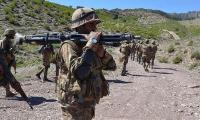After years of vitriol, when the Iran nuclear agreement was operationalised there was a routine quietness about it that belied the scale of the transformation that had been set into motion.
For one, after almost 35 years of hostility, the US and Iran are interacting and talking to each other. The release of US prisoners and an effort to downplay the naval incident reflected the new realities of the US-Iran relationship. Not that everything is now a love fest between the two – as was made clear in the new sanctions imposed by the US against Iran testing a ballistic missile – but Iran will now become a gradually recognised inclusive player in the region, especially in the fight against Daesh in Syria and Iraq.
Despite serious overt efforts to sabotage the nuclear deal by Israel and the US Congress along with covert efforts by the Saudis (KSA), all sides involved in seeking a deal were determined to see it through – and they did.
For Iran, the lifting of sanctions brings immediate benefits as Iranian assets are no longer frozen resulting in Iran getting $150 billion ‘automatically’ along with the possibility of lucrative investments. The Iranian leadership has been quick to capitalise on the occasion as reflected in the trip to Italy by President Rouhani. Apart from signalling the possibility of European investment flowing into Iran, the meeting between President Rouhani and the Pope had a strong symbolic politico-religious message. Earlier, when the US imposed the new anti-missile sanctions on Iran, these were unilateral and the Europeans remained out.
For Europe, Iran’s energy reserves present opportunities, as Iran is the world’s third largest natural gas producer, after Russia and the US. The Germans, particularly, have suffered on the gas supply issue with the Russian-Ukrainian conflict aggravating matters.
So has Iran altered its core policies in the region? It seems more likely that it has changed its strategy in so far as it has sought to play the diplomacy card more effectively – as it has also seen the negative fallout of aggressive covert strategies. The Yemen war, bringing into play the military GCC coalition, has been an example of a covert operation spiralling into a devastating war. As it seeks a greater role in defining the region, Iran has realised the benefits of effective diplomacy. In Syria, the position taken by Iran has been bolstered by Russia and China also seeking the defeat of Daesh delinked from removal of the Assad regime.
Again, as the KSA-Iran crisis reached a confrontational stage, the Iranian leadership condemned the attack on the Saudi embassy and consulate in Iran and made quick arrests too. While the crisis persists, the Iranians are keeping a low profile. Not much has been said in terms of violent rhetoric on the Saudi efforts to create the 34-nation military alliance – which Pakistan insists is not an alliance but merely a coalition – against terrorism which excludes Iran despite it being one of the major states actually fighting Daesh on the ground.
Not that Iran has or will forsake its allies in the region – allies like Hamas and Hezbollah who are the bulwarks against Israeli militarism and oppression of the Palestinians. However, Iran now finds itself back in the mainstream of the comity of nations and has begun to adjust its strategies and tactics accordingly. How far its policies will undergo shifts, and whether these will be simply shifts in nuances or actual substance, remains to be seen.
After all, within Iran, the battle between the moderates and hardliners is still being fought out and the elections next month will reflect the direction in which Iran will be going. Whichever direction is charted out, it will be forward movement from the nuclear deal not a regression. Iran has gone through its internal debates on the nuclear agreement and these have been severe and polarised even after the signing of the agreement; but now the deed is done and sanctions are a thing of the past.
Hostilities will persist between the US and its allies, on the one hand, and Iran, on the other, on many international issues but the dynamics will be different and will not necessarily be zero-sum games. After all, the timing of the KSA-Iran crisis, just before the nuclear agreement became operational, failed to delay the agreement’s final steps and the lifting of sanctions.
Ironically, while Pakistan has been slow to adjust to the new regional dynamics of an internationally mainstreamed Iran, it has felt the fallout of the nuclear agreement almost immediately – with the US now fully devoting its anti-nuclear histrionics once again towards Pakistan. Was it a mere coincidence that the Congressional Research Service put out yet another paper on Pakistan’s nuclear programme with the usual alarmist ring to it on 14 January? As the Iran nuclear issue dies out, and the US’ inexplicably benevolent approach to North Korea’s nuclear adventurism continues, Pakistan’s nuclear programme becomes the target once again. Alongside, Congress has also moved to stop the sale of eight F16s to Pakistan.
Nor is this all! Was it a mere coincidence that President Obama suddenly took to targeting Pakistan twice within the space of a few days, including asserting the country would remain destabilised for decades?
Meanwhile, the US-India military strategic partnership has now moved from beyond simply nuclear technology transfers and missile defence cooperation to logistic support allowing both states to access each other’s bases. The same European states that are moving to sell commercial planes and other hardware to Iran are also moving to sell nuclear power plants and fighter planes to India. All that echoes across to Pakistan is ‘do more’.
India has a growing relationship with Iran even as it has workers in KSA and a huge presence in the GCC states – and the one does not impact the other. Pakistan is still shying away from the Iran-Pakistan pipeline despite its severe energy crunch. Pakistan’s moves towards Iran are overshadowed by vested interests and a self-created fear of imagined consequences from KSA and the GCC states. Sadly, we still haven’t grasped the qualitative shift that has been brought into play by the Iran nuclear agreement.
The writer is DG of SSII, a private think tank, and a PTI MNA. The views expressed are her own.
Email: callstr@hotmail.com
Economic nationalism remains potent political narrative, influencing both Republican and Democratic platforms
Yes, blockchain, decentralised and distributed ledger technology, is foundational backbone of cryptocurrencies
Blue carbon covers merely 2.0 per cent of ocean surface but absorbs 50 per cent of carbon dioxide
During WWII, Japan’s economy and national morale were plummeted by its doomed alliance with Germany
More than 40 persons, including women and children, were killed in Parachinar
After November 30, it will be impossible for ordinary internet users to access all banned websites, including X







